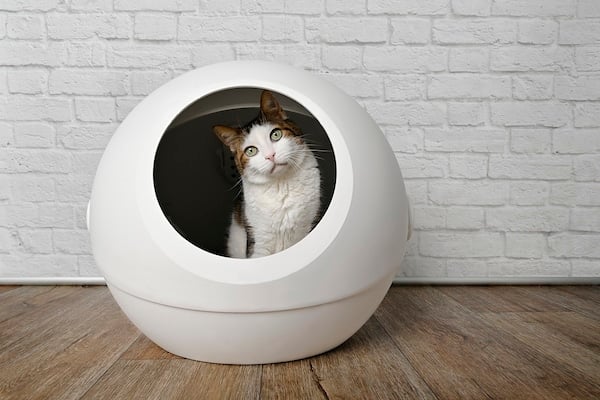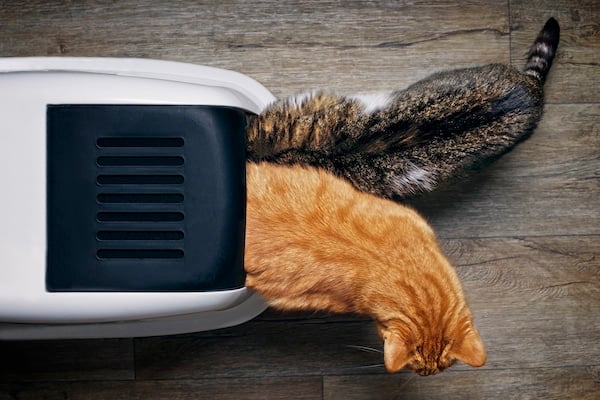- This post contains affiliate links. Read more here.
- Not a substitute for professional veterinary help.
An automatic litter box that cleans itself seems like the ultimate luxury for hard-working cat parents. But will your cat agree? She might—or she might not. And since self-cleaning boxes are a considerably high-ticket item, the latter scenario would be a pretty painful blow to your wallet.
While some element of risk is unavoidable with automatic litter boxes, there are strategies to help your cat get on board—even if they’re reluctant at first.
Potential Pitfalls of Automatic Litter Boxes
Some cats won’t mind switching to a high-tech litter box. They might even prefer one if they’re the fastidious type. Other cats could find these unusual models terrifying, and some may even stage a potty strike.
For the smoothest transition, consider how your cat might react to the following features. This will help you prepare an appropriate training strategy ahead of time (more on that below).
- Self-cleaning litter boxes are noisy: All that whirring machinery can scare a noise-sensitive cat, as one of our feline Rover testers discovered with the Leo’s Loo Too model.
- They’re unfamiliar: Cats aren’t exactly known for liking new things. I can’t imagine how my own senior scaredy cat, Amber, would react to a space-age gadget taking the place of her old litter box. (Actually, I can. She’d be mortified.) Novelty isn’t always a deal-breaker, though. It just means your cat might need extra time to adjust.
- Size may be an issue: While they appear large from the outside, these boxes are actually much smaller on the inside. “Because of the mechanisms in the motor taking up space, there’s usually small real estate available for the actual litter,” says Katenna Jones, ACAAB, a certified cat behaviorist at Cat World. If your cat is on the larger side, Jones recommends getting the biggest model you can afford.
- Most models are enclosed: Preferences vary, and some cats will actually enjoy the privacy of a hooded litter box. But if your cat isn’t used to a covered box, it might take time (and treats and praise) for them to acclimate to one.
- Malfunctions are possible: There’s also the occasional technical glitch, Jones points out. “A malfunctioning box can go off while the cat is inside using it. Have you ever had a public toilet flush while you were still using it? Ladies, you know what I mean!” she jests. For an already nervous cat, this could halt any progress and require you to double-down on training.
If any of these strike a chord, don’t despair—even if your cat is reluctant to try their new potty, we have seven steps that may help you win them over to a self-cleaning litter box.

Lightspruch via iStock
7 Strategies for Getting Your Cat To Use a Self-Cleaning Litter Box
The most important part of transitioning your kitty to a new litter box? Patience. The training process could take up to a couple of weeks. But if it sticks, an automatic litter box could be a real game-changer.
1. Pick the right location
According to cat behaviorist Janet Cutler, Ph.D., cat parents should place the new litter box in the same location as the original. But don’t discard the old one just yet—keep it nearby in case your cat is unsure of the new model at first.
With both boxes side-by-side, take a scoop of litter from the old box and add it to the automatic model. The familiar scent should reassure a kitty who’s still on the fence.
2. Give them a chance to explore
Cutler and Jones both agree it’s wise to allow for a period of adjustment. Give your cat one to two weeks to investigate (and hopefully use) their new potty chamber—without turning it on yet. The folks at Litter-Robot recommend waiting until your cat has used the new box before activating it.
3. Turn the new litter box on with your cat nearby
Once your cat has made a successful deposit in the new box (hooray!), it’s safe to run the machine’s clean cycle with them in the same room. With you there to reassure them, your cat can get used to the sound and motion in a safe setting.

Lightspruch via iStock
4. Stop scooping the old box
Ignoring a dirty litter box takes some resolve, but if you can hold off for a day or so, the stink may just pay off. Cats aren’t fans of using a soiled litter box, so letting waste accumulate could start to make that pristine self-cleaning box look real good.
5. Make modifications if the model allows
There are several different types of automatic litter boxes. Many of them have an enclosed design, which your cat may love—or hate. If they’re not a fan, you might be able to remove the cover, depending on the design. Once your cat becomes settled into their new bathroom routine, you can try replacing the lid.
6. Add rewards!
You may be able to coax an incurious kitty to use their new automatic litter box with treats, toys, and catnip. Try placing a few of your cat’s favorite goodies on the steps of the new litter box to lure them in. And don’t forget to pile on the praise and rewards every time they use the new box to build positive associations with the device.
7. Go slow and be patient
Janet Cutler offers a good final reminder to cat parents: “Remember that this can be a very new and potentially scary experience for your cat,” she says. “To prevent any future kitty litter problems with your cat, make sure you let them take their time and get comfortable using a new kitty litter box.”
How long will the transition take? Depending on your cat’s willingness and your own commitment to training, it could take a few short days or up to a couple of weeks. Once your cat is consistently using their new box, you can remove the old one. And should they revert to potty-ing on the floor, you can return the old pan and give the process a second try.

Lightspruch via iStock
Knowing When an Electronic Litter Box Isn’t a Good Fit
If despite all your efforts, your cat still isn’t interested, it might be time to call it quits. Introducing any changes to your cat’s environment can be met with resistance, so this is always a risk. But at the end of the day, an unused litter box doesn’t do anyone any good.
While some folks may balk at re-gifting, we think most will make an exception for pricey pet tech. If you can find a fellow cat parent willing to take a failure off your hands, it should soften some of the sting.
The best way to avoid the heartache of unused pet gear in the first place? Consider your cat’s likes and dislikes, and ask yourself:
- Is my cat usually open to new things? Or does the unknown scare them easily?
- How do they feel about noise? Or enclosed spaces?
- Do they require a pristine box (and could you use the help keeping it that way)?
You know your cat best. if you think they could be persuaded to use an automatic, self-cleaning litter box, it could be the answer to your litter-cleaning woes.
Further Reading
- Are Self-Cleaning Litter Boxes Worth the Money?
- The Best Self-Cleaning Litter Boxes for Cats—and Cat Parents
- Leo’s Loo Too Review: The Smart Litter Box Changing Your Cat’s Litter Game
- The Best Litter Boxes for Picky Cats—In Every Style
- How Many Litter Boxes Do You Need Per Cat?
- Kitty Poo Club Review: Is the Subscription Litter Box Service for You?





